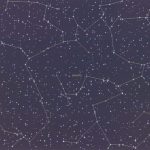Mark Tribe: StarryNight
Artist(s):
Title:
- StarryNight
Exhibition:
Creation Year:
- 2003
Size:
- 20 in x 24 in
Category:
Artist Statement:
This is a digital C-print from StarryNight (rhizome.org/starrynight), a net art project that serves as an interface to the text archive on the Rhizome.org web site. Rhizome.org is an online platform for the global new-media art community. It has thousands of members in dozens of countries. The Rhizome text archive contains over 2,000 articles written by hundreds of Rhizome members since 1996.
Each of the stars on StarryNight corresponds to one of the texts in the archive. The brightness of each star is determined by the number of times the corresponding text has been read. Each time someone reads a text, the corresponding star gets a bit brighter. So the brightest stars represent the most popular texts.
Clicking on a star triggers a special pop-up menu. You can either click “read message,” which causes the corresponding text to pop up on screen, or select a keyword associated with that text, which draws a map linking together all of the stars sharing that keyword into a constellation.
You can use these constellations to find other related texts, and in doing so, follow your interests through the vast array of ideas and information in the archive.
Anyone can create a star by signing up as a Rhizome.org member and contributing
an announcement, comment, review, interview, or other text to the archive. And by using StarryNight, you increase the brightness of the stars corresponding to the texts you read, leaving a visible trace of your activity (intensities are updated daily, so results are not immediate).
StarryNight depends on two pieces of original software: a set of Perl scripts that sort texts by keyword and record their individual hits and a Java applet that filters this information to draw stars and constellations. To access StarryNight, you need Internet Explorer 4.x or higher on Windows or Navigator 4.5 or higher on Macintosh.
StarryNight is both a mirror and a map. On the one hand, it offers a reflection of the Rhizome.org community’s reading habits. It is up to you to decide whether to click on a bright, popular star, or a dim one that represents a text that fewer people have read. On the other hand, it acts as a navigational interface by connecting similar stars/texts into constellations regardless of their brightness.






